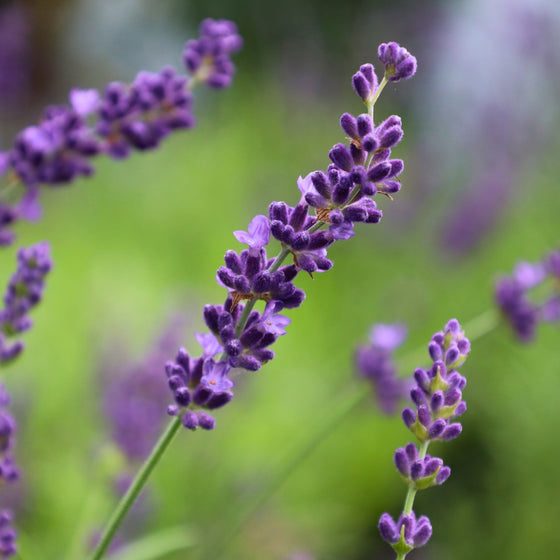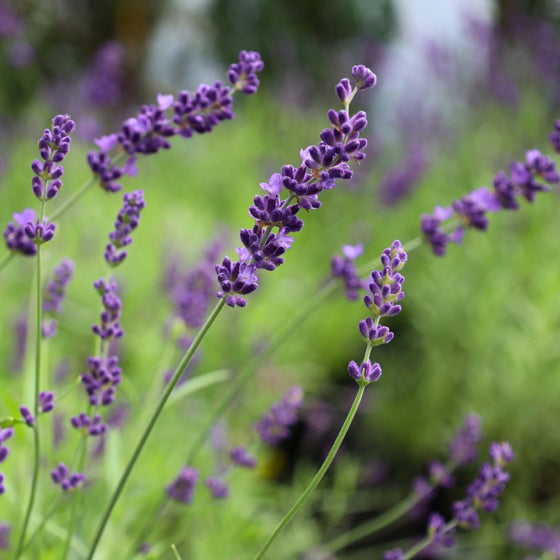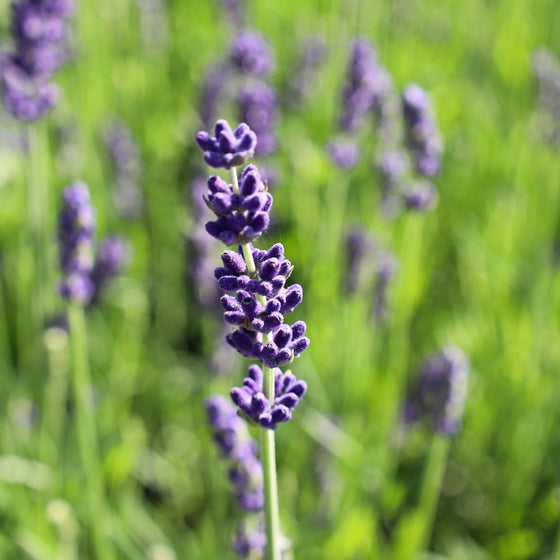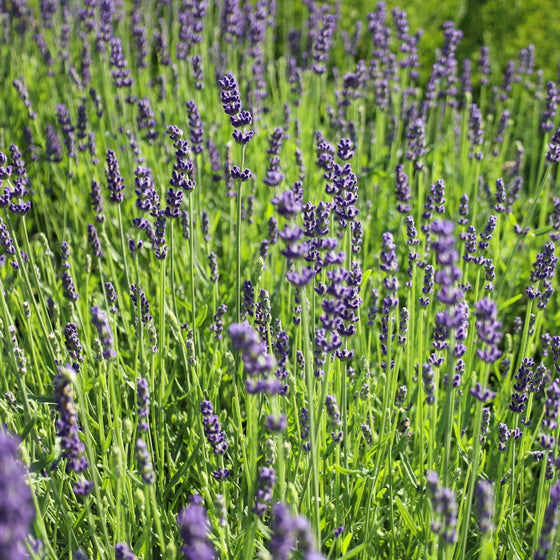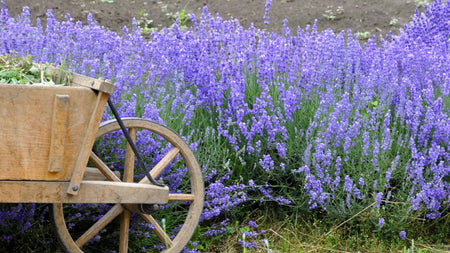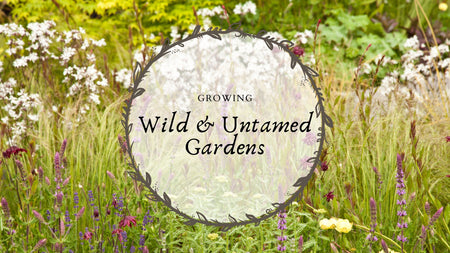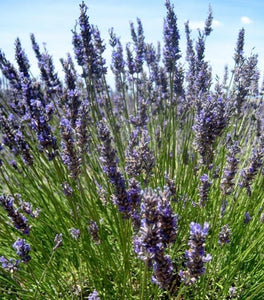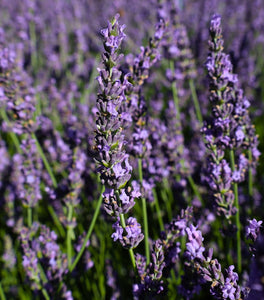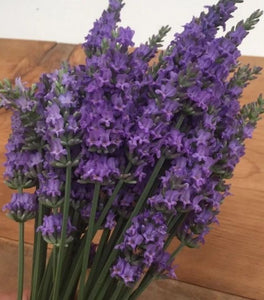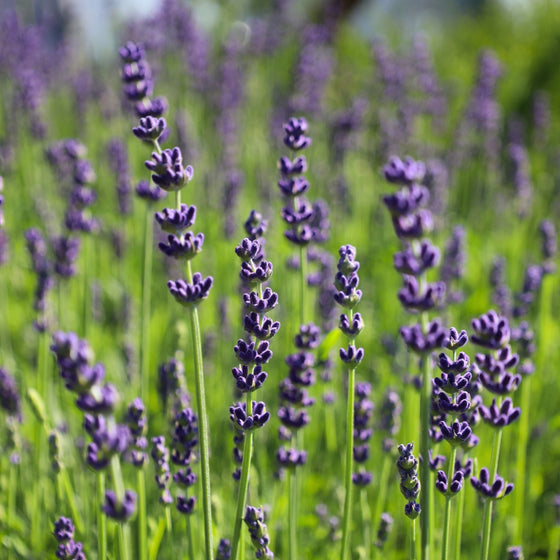
Images Depict Mature Plants
Hidcote Lavender for Sale Online
Lavender 'Hidcote' (Lavandula angustifolia 'Hidcote') is a classic English lavender cultivar known for its deep violet-blue flower spikes, compact form, and intensely fragrant foliage. Blooming from early to mid-summer, this drought-tolerant perennial is a favorite for borders, herb gardens, pollinator plantings, and containers. Its aromatic gray-green foliage and richly colored blooms make it equally attractive fresh or dried, adding beauty and fragrance to garden beds, bouquets, sachets, and crafts.
'Hidcote' Lavender typically grows 18 to 24 inches tall and wide, making it ideal for edging walkways or creating a low, colorful hedge. It thrives in full sun and well-drained, sandy or rocky soils, and once established, it requires little water, making it a top choice for xeriscaping and Mediterranean-style landscapes. This hardy perennial is resistant to deer and rabbits and attracts bees, butterflies, and other pollinators, supporting biodiversity while delivering vibrant garden color and structure.
Perfect for USDA zones 5–9, Lavender 'Hidcote' is one of the best lavenders for cooler climates due to its cold-hardiness and compact habit. It pairs beautifully with roses, yarrow, salvia, and ornamental grasses, offering both contrast and cohesion in the landscape. Whether planted en masse, as a border accent, or in decorative containers, 'Hidcote' Lavender adds timeless charm, soothing fragrance, and year-round appeal with minimal maintenance.
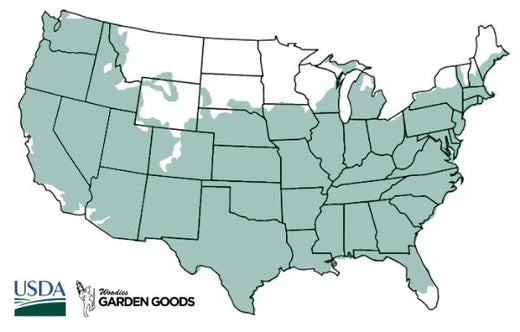
| Hardiness Zone: | 5-9 |
|---|---|
| Mature Height: | 1 to 1.5 feet |
| Mature Width: | 1.5 to 2 feet |
| Sunlight: | Full sun |
| Water Requirements: | Water well until established |
| Selling Points: | Fragrant foliage, deer resistant, attracts butterflies |
How to Care for Lavender Hidcote
Be sure to read our planting instructions to ensure a healthy and happy Lavender Hidcote for years to come!
How do I plant a Lavender Hidcote Plant?
To plant a Lavender 'Hidcote' (Lavandula angustifolia 'Hidcote') successfully, choose a location that receives full sun for at least 6 to 8 hours per day and offers excellent air circulation. This English lavender variety thrives in well-drained, slightly alkaline soil with low to moderate fertility—making it perfect for sandy or rocky soil conditions. Avoid heavy clay or overly rich soil, as excess moisture can lead to root rot. Dig a hole twice as wide as the root ball and just as deep, and mix in a handful of sand or gravel if your soil retains too much water. Set the lavender in the hole with the crown just above the soil line, backfill with soil, and gently firm it in place. After planting, water your Lavender 'Hidcote' thoroughly to help establish the roots, but be sure not to overwater. Once established, this drought-tolerant plant needs only occasional watering, making it a great choice for low-maintenance or xeriscape gardens. Space plants 18 to 24 inches apart to allow for good airflow, which helps prevent fungal issues and keeps the plant looking its best. Ideal for borders, pathways, rock gardens, and containers, Lavender 'Hidcote' offers a stunning combination of fragrance, color, and texture while attracting pollinators and resisting deer and rabbits. With the right planting technique, this lavender will thrive and bring beauty to your garden for years.
How do I Water a Lavender Hidcote Plant?
Watering a Lavender 'Hidcote' (Lavandula angustifolia 'Hidcote') plant properly is essential for establishing strong roots and promoting healthy, fragrant blooms. During the first growing season, water deeply once or twice a week, allowing the soil to dry out between waterings. This deep watering encourages the plant to develop a deep root system, which increases its drought tolerance as it matures. Always water at the base of the plant to keep the foliage dry, which helps prevent fungal diseases and root rot—two common issues when lavender is overwatered or grown in poorly drained soil. Once established, Lavender 'Hidcote' is highly drought-tolerant and requires minimal watering, making it an excellent choice for water-wise and low-maintenance landscapes. In general, water only during extended dry periods, and avoid overwatering, which can be more harmful than under-watering for this Mediterranean herb. Overly wet conditions can cause root damage and reduce flower production. A layer of gravel mulch around the base can help improve drainage and reduce weed growth. With proper watering practices, Lavender 'Hidcote' will thrive in borders, herb gardens, and containers, delivering long-lasting fragrance and color with minimal care.
How do I Fertilize a Lavender Hidcote Plant?
Fertilizing a Lavender 'Hidcote' (Lavandula angustifolia 'Hidcote') plant should be done sparingly, as this drought-tolerant perennial thrives in lean, well-drained soil. Over-fertilizing can lead to excessive foliage growth at the expense of fragrant blooms and may reduce the plant’s natural compact shape. In early spring, apply a light dose of a balanced, low-nitrogen fertilizer—such as a 5-10-10 blend—or amend the soil with a small amount of compost to give the plant a gentle boost. Always apply fertilizer around the base of the plant, keeping it away from the crown, and water lightly afterward to help nutrients absorb into the soil. For gardeners preferring organic methods, a handful of compost or a light top-dressing of bone meal once a year is usually sufficient to support blooming without overfeeding. Avoid high-nitrogen fertilizers, which can cause floppy, weak growth and increase the risk of disease. Since Lavender 'Hidcote' is naturally adapted to nutrient-poor conditions, minimal fertilization is ideal to encourage strong stems, compact growth, and an abundance of violet-blue flowers. With the right light feeding regimen, this resilient lavender variety will thrive in herb gardens, borders, and containers, rewarding you with beautiful, fragrant blooms season after season.

How and When should I Prune a Lavender Hidcote Plant?
Pruning a Lavender 'Hidcote' (Lavandula angustifolia 'Hidcote') plant is essential for maintaining its compact shape, promoting vigorous growth, and encouraging abundant blooms. The best time to prune is twice per year: lightly in the spring and more thoroughly after flowering in late summer or early fall. In early spring, trim back any winter-damaged tips and shape the plant slightly to stimulate new growth. After the plant finishes blooming, perform a more substantial pruning by cutting back about one-third of the plant's height, being careful not to cut into the woody stems, as lavender does not regenerate well from old wood. Consistent annual pruning helps prevent the Lavender 'Hidcote' plant from becoming leggy or woody at the base, preserving its tidy, rounded form. Use clean, sharp shears and always aim to leave a few inches of green growth above the woody base to ensure the plant rebounds the following season. Regular deadheading of spent blooms throughout the summer can also prolong flowering and enhance the plant's appearance. With the right timing and technique, pruning will keep your Lavender 'Hidcote' healthy, bushy, and full of fragrant, violet-blue blooms—making it a standout in borders, herb gardens, and decorative containers year after year.

